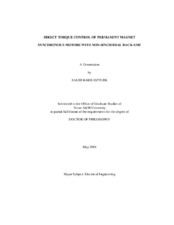| dc.description.abstract | This work presents the direct torque control (DTC) techniques, implemented in
four- and six-switch inverter, for brushless dc (BLDC) motors with non-sinusoidal back-
EMF using two and three-phase conduction modes. First of all, the classical direct torque
control of permanent magnet synchronous motor (PMSM) with sinusoidal back-EMF is
discussed in detail. Secondly, the proposed two-phase conduction mode for DTC of
BLDC motors is introduced in the constant torque region. In this control scheme, only
two phases conduct at any instant of time using a six-switch inverter. By properly
selecting the inverter voltage space vectors of the two-phase conduction mode from a
simple look-up table the desired quasi-square wave current is obtained. Therefore, it is
possible to achieve DTC of a BLDC motor drive with faster torque response while the
stator flux linkage amplitude is deliberately kept almost constant by ignoring the flux
control in the constant torque region.
Third, the avarege current controlled boost power factor correction (PFC) method
is applied to the previously discussed proposed DTC of BLDC motor drive in the
constant torque region. The test results verify that the proposed PFC for DTC of BLDC motor drive improves the power factor from 0.77 to about 0.9997 irrespective of the
load.
Fourth, the DTC technique for BLDC motor using four-switch inverter in the
constant torque region is studied. For effective torque control in two phase conduction
mode, a novel switching pattern incorporating the voltage vector look-up table is
designed and implemented for four-switch inverter to produce the desired torque
characteristics. As a result, it is possible to achieve two-phase conduction DTC of a
BLDC motor drive using four-switch inverter with faster torque response due to the fact
that the voltage space vectors are directly controlled..
Finally, the position sensorless direct torque and indirect flux control (DTIFC) of
BLDC motor with non-sinusoidal back-EMF has been extensively investigated using
three-phase conduction scheme with six-switch inverter. In this work, a novel and simple
approach to achieve a low-frequency torque ripple-free direct torque control with
maximum efficiency based on dq reference frame similar to permanent magnet
synchronous motor (PMSM) drives is presented. | en |


